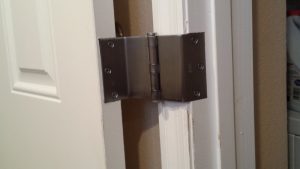We all see our worlds through our own eyes. We make our choices and structure our lives based on what we know personally. If we are not disabled and we don’t live with someone who is disabled, why would we make our homes “handicapped-friendly”?
In the world of “public accommodation” (stores, restaurants, churches, offices, etc.) the ADA (Americans with Disabilities Act) has resulted in vast improvements. Persons with disabilities can now go almost anywhere.
But not in private homes.
Visiting friends or family members at their homes can be the most predictably treacherous endeavors that those of us with disabilities face. We often choose to “Just Say No” when invited, but saying “Yes” and trying to make visits possible can be rewarding.
When we agree to go to a private home, planning is critical. Some homes are simply impossible to visit, a rare few are perfect and many are possible with creativity and modest modifications.
The hosts we are visiting want to make our trips successful. And, of course, so do we. For that to happen we’ve found several important factors.
- Careful planning – by them and by us. Can we get in the door? Can we move around in the house? What about the bathroom? Which devices should we bring?
- Creative problem solving – Often there is no ideal solution, but jury-rigging can work for that one event on that one afternoon. Over the years we’ve seen countless makeshift ramps, wheelchair alternatives and party modifications. (“How about just staying out here on the patio?”)
- Engage anyone who wants to help and don’t be too proud to accept it. It is possible that my greatest barrier to having fun at friend’s houses is my own discomfort with accepting my new reality. It helps me to remember that if the tables were turned I would gladly be helping them.
Until we live in a world where there are no more disabilities or every home is handicapped-friendly (quite unlikely, I know!), thoughtful compromise will be the way that people with disabilities continue to participate as guests in the homes of our friends and families. It can be well worth the effort!
Success Stories:
D & B’s House – They have a single story home, so we all assumed that there would be no problems with access. Until we arrived with a powerchair that wouldn’t climb the step to the front door. Two husbands, a dose of creativity, a few 2X4s laid on their sides to form a wedge shape and a small piece of carpet created an acceptable ramp in less than 10 minutes.

K & S’s House – Like in many homes, the guest bathroom is small and not accessible . After thinking through a variety of unworkable alternatives the simplest solution came to us – Isn’t the master bathroom larger? The only thing we had to modify was our thinking!
D & M’s house – A 60 year old house was not designed to meet current accessibility codes. But even here adjustments were possible.
- An old door was modified to make a ramp into the house.
- By using the lightest weight manual wheelchair we had, it made moving over inclines easier for the “pushers”.
- And installing “Swing-away” door hinges make door openings wider with no other changes.

In several situations we’ve experienced, the modifications made for a disabled guest came to be seen as welcome improvements for the able-bodied residents too!
Please send us your success stories and pictures as well.

 This website is designed to give you practical tips, advice and links that will support your journey to seek out the solutions that work best for you.
This website is designed to give you practical tips, advice and links that will support your journey to seek out the solutions that work best for you.